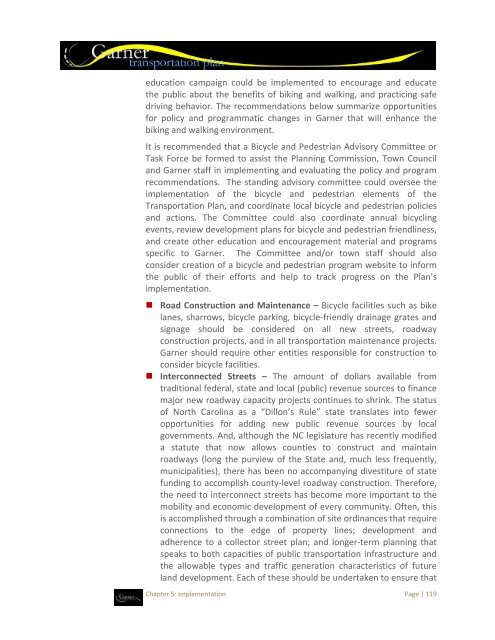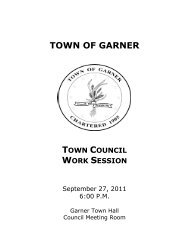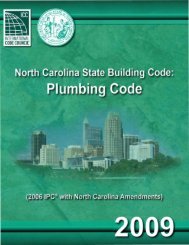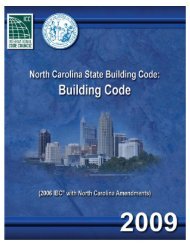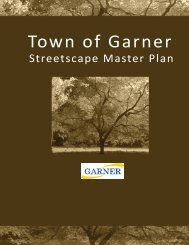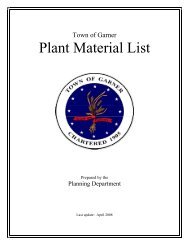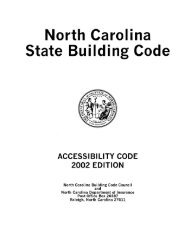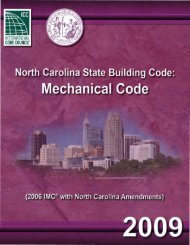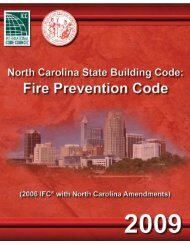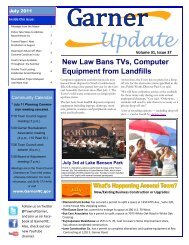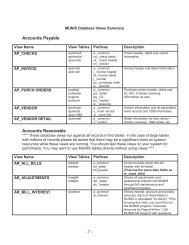Transportation Plan - Town of Garner
Transportation Plan - Town of Garner
Transportation Plan - Town of Garner
Create successful ePaper yourself
Turn your PDF publications into a flip-book with our unique Google optimized e-Paper software.
education campaign could be implemented to encourage and educate<br />
the public about the benefits <strong>of</strong> biking and walking, and practicing safe<br />
driving behavior. The recommendations below summarize opportunities<br />
for policy and programmatic changes in <strong>Garner</strong> that will enhance the<br />
biking and walking environment.<br />
It is recommended that a Bicycle and Pedestrian Advisory Committee or<br />
Task Force be formed to assist the <strong>Plan</strong>ning Commission, <strong>Town</strong> Council<br />
and <strong>Garner</strong> staff in implementing and evaluating the policy and program<br />
recommendations. The standing advisory committee could oversee the<br />
implementation <strong>of</strong> the bicycle and pedestrian elements <strong>of</strong> the<br />
<strong>Transportation</strong> <strong>Plan</strong>, and coordinate local bicycle and pedestrian policies<br />
and actions. The Committee could also coordinate annual bicycling<br />
events, review development plans for bicycle and pedestrian friendliness,<br />
and create other education and encouragement material and programs<br />
specific to <strong>Garner</strong>. The Committee and/or town staff should also<br />
consider creation <strong>of</strong> a bicycle and pedestrian program website to inform<br />
the public <strong>of</strong> their efforts and help to track progress on the <strong>Plan</strong>’s<br />
implementation.<br />
• Road Construction and Maintenance – Bicycle facilities such as bike<br />
lanes, sharrows, bicycle parking, bicycle‐friendly drainage grates and<br />
signage should be considered on all new streets, roadway<br />
construction projects, and in all transportation maintenance projects.<br />
<strong>Garner</strong> should require other entities responsible for construction to<br />
consider bicycle facilities.<br />
• Interconnected Streets – The amount <strong>of</strong> dollars available from<br />
traditional federal, state and local (public) revenue sources to finance<br />
major new roadway capacity projects continues to shrink. The status<br />
<strong>of</strong> North Carolina as a “Dillon’s Rule” state translates into fewer<br />
opportunities for adding new public revenue sources by local<br />
governments. And, although the NC legislature has recently modified<br />
a statute that now allows counties to construct and maintain<br />
roadways (long the purview <strong>of</strong> the State and, much less frequently,<br />
municipalities), there has been no accompanying divestiture <strong>of</strong> state<br />
funding to accomplish county‐level roadway construction. Therefore,<br />
the need to interconnect streets has become more important to the<br />
mobility and economic development <strong>of</strong> every community. Often, this<br />
is accomplished through a combination <strong>of</strong> site ordinances that require<br />
connections to the edge <strong>of</strong> property lines; development and<br />
adherence to a collector street plan; and longer‐term planning that<br />
speaks to both capacities <strong>of</strong> public transportation infrastructure and<br />
the allowable types and traffic generation characteristics <strong>of</strong> future<br />
land development. Each <strong>of</strong> these should be undertaken to ensure that<br />
Chapter 5: Implementation Page | 119


